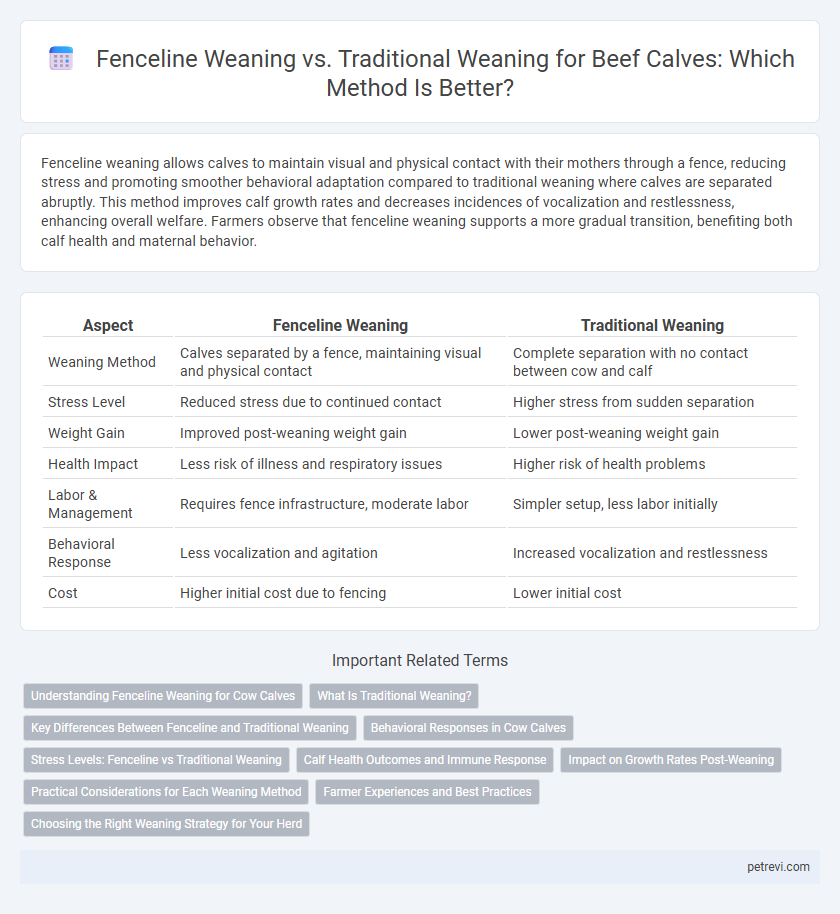Fenceline weaning allows calves to maintain visual and physical contact with their mothers through a fence, reducing stress and promoting smoother behavioral adaptation compared to traditional weaning where calves are separated abruptly. This method improves calf growth rates and decreases incidences of vocalization and restlessness, enhancing overall welfare. Farmers observe that fenceline weaning supports a more gradual transition, benefiting both calf health and maternal behavior.
Table of Comparison
| Aspect | Fenceline Weaning | Traditional Weaning |
|---|---|---|
| Weaning Method | Calves separated by a fence, maintaining visual and physical contact | Complete separation with no contact between cow and calf |
| Stress Level | Reduced stress due to continued contact | Higher stress from sudden separation |
| Weight Gain | Improved post-weaning weight gain | Lower post-weaning weight gain |
| Health Impact | Less risk of illness and respiratory issues | Higher risk of health problems |
| Labor & Management | Requires fence infrastructure, moderate labor | Simpler setup, less labor initially |
| Behavioral Response | Less vocalization and agitation | Increased vocalization and restlessness |
| Cost | Higher initial cost due to fencing | Lower initial cost |
Understanding Fenceline Weaning for Cow Calves
Fenceline weaning for cow calves involves keeping calves in close proximity to their mothers but separated by a fence, reducing stress by allowing visual and limited physical contact. This method promotes gradual separation, leading to improved weight gain and lower cortisol levels compared to traditional abrupt weaning. Research indicates that calves undergoing fenceline weaning exhibit better behavioral responses and reduced vocalization, enhancing overall welfare during the weaning process.
What Is Traditional Weaning?
Traditional weaning involves abruptly separating cow calves from their mothers, typically at 6 to 8 months of age, causing immediate cessation of nursing. This method often leads to significant stress for calves, reflected in vocalizations, reduced feed intake, and weight loss. Despite its simplicity, traditional weaning can negatively impact calf growth and welfare compared to more gradual alternatives like fenceline weaning.
Key Differences Between Fenceline and Traditional Weaning
Fenceline weaning allows calves to maintain visual and physical contact with their dams through a fence, reducing stress and promoting smoother behavioral transition compared to traditional weaning, which involves complete separation. Traditional weaning typically results in elevated cortisol levels and increased vocalization, whereas fenceline weaning lowers stress-related physiological responses and improves post-weaning weight gain. This method enhances calf welfare by minimizing separation anxiety and supports better overall health outcomes during the weaning period.
Behavioral Responses in Cow Calves
Fenceline weaning significantly reduces stress-related behaviors such as vocalization, restlessness, and pacing in cow calves compared to traditional weaning, promoting better emotional well-being. Calves separated by fenceline maintain visual, auditory, and tactile contact with their mothers, leading to smoother behavioral transitions and improved feeding activity. Behavioral studies highlight lower cortisol levels and increased social interaction among calves weaned using fenceline methods versus those subjected to abrupt separation.
Stress Levels: Fenceline vs Traditional Weaning
Fenceline weaning significantly reduces stress levels in cow calves compared to traditional weaning by allowing continuous visual and limited physical contact with their mothers, minimizing separation anxiety. Studies show lower cortisol concentrations and less vocalization in calves subjected to fenceline weaning, indicating reduced physiological and behavioral stress responses. Traditional weaning often causes abrupt separation, leading to increased agitation, weight loss, and compromised immune function in calves.
Calf Health Outcomes and Immune Response
Fenceline weaning of cow calves significantly improves calf health outcomes by reducing stress and promoting better weight gain compared to traditional weaning methods. Studies show enhanced immune response in calves undergoing fenceline weaning, evidenced by higher levels of immunoglobulins and reduced incidence of respiratory diseases. This weaning technique supports stronger disease resistance and faster recovery, contributing to overall calf vitality.
Impact on Growth Rates Post-Weaning
Fenceline weaning promotes higher growth rates in cow calves compared to traditional weaning by reducing stress through partial contact with the dam during the transition. Studies show calves weaned via fenceline methods maintain better feed intake and exhibit less weight loss immediately post-weaning. This approach supports improved average daily gain (ADG) and enhances overall growth performance during the critical post-weaning period.
Practical Considerations for Each Weaning Method
Fenceline weaning allows calves to maintain visual and tactile contact with their mothers, reducing stress and promoting better weight gain compared to traditional abrupt weaning. This method requires secure fencing and adequate pasture space to prevent physical contact while allowing sensory interaction. Traditional weaning, while simpler to implement, often leads to higher cortisol levels and weight loss due to sudden separation, necessitating careful monitoring and nutritional support during the transition.
Farmer Experiences and Best Practices
Farmers practicing fenceline weaning report reduced calf stress and improved weight gain compared to traditional abrupt separation methods. Best practices include maintaining a secure but visible barrier to allow calves to see and hear their mothers, promoting smoother behavioral adjustment. Consistent monitoring and gradual transition before complete separation enhance welfare outcomes and ease labor demands.
Choosing the Right Weaning Strategy for Your Herd
Fenceline weaning reduces stress by allowing calves to remain in sight and sound of their mothers, promoting better feed intake and weight gain compared to traditional abrupt weaning methods. Choosing the right weaning strategy depends on herd size, facility design, and labor availability, with fenceline weaning often preferred for its welfare benefits and smoother transition. Monitoring calf health and behavior post-weaning ensures optimal growth and minimizes respiratory disease risks associated with stressful separations.
Fenceline Weaning vs Traditional Weaning for Cow Calves Infographic

 petrevi.com
petrevi.com